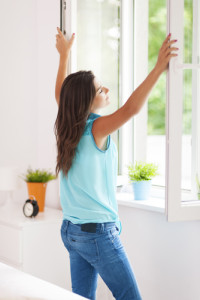 The last thing you want during a Florida summer is a hot, muggy home with no air circulation. While the air conditioner is your best friend on the hottest summer afternoons, home ventilation can work wonders, cooling off your home at a fraction of what air conditioning costs. Consider these alternatives to blasting the air conditioner next time you want to cool off.
The last thing you want during a Florida summer is a hot, muggy home with no air circulation. While the air conditioner is your best friend on the hottest summer afternoons, home ventilation can work wonders, cooling off your home at a fraction of what air conditioning costs. Consider these alternatives to blasting the air conditioner next time you want to cool off.
Natural Ventilation
All homes have windows, and not just for the view, but for ventilation purposes as well. The cheapest way to cool off on mild days is to open a window. Better yet, create a cross breeze by opening windows on opposite walls.
You can also open several windows at night when it cools down outside. Just make sure you check the forecast first. Summer nights in Florida often stay hot and muggy, so only leave the windows open when the temperature is supposed to drop into the 70s or lower. Then, be quick to close the windows in the morning to trap nighttime air inside. This tactic helps you put off turning on the air conditioner and can save you significantly during the summer months.
Fans
The purpose of turning on a fan is to move air around. One great home ventilation method is to put box fans in the windows to actively draw fresh air inside. This is more effective than simply leaving the windows open and hoping a breeze will enter.
You can also circulate air while the windows are closed by turning on the ceiling fan. While the fan doesn’t actually ventilate your home, the air movement makes you feel cooler. In fact, while the fan in running, you can turn up the thermostat about 4 degrees and still remain comfortable. This amounts to significant energy savings, since fan motors consume a tiny fraction of the electricity needed to run an air conditioner.
If you choose to run the ceiling fan, just remember to turn it off when you leave the room. Fans generate cooling airflow, but they don’t actually lower the temperature in the room. Operating a ceiling fan 24 hours a day wastes energy.
Spot Ventilation
Most homes have exhaust fans in the kitchen, bathroom and laundry room. These locations are deliberate. Think about the activities that occur in these rooms. Cooking, showering and running the dryer produce heat and steam you don’t want in your home.
Close the door to these rooms and run the exhaust fans to draw heat and humidity outside. Turn the exhaust fans off when you don’t need them to conserve energy and prevent depressurizing your home, which encourages hot outdoor air to enter through gaps and cracks in your home’s outer envelope.
Attic Fans
In cool climates, whole-house fans are a good option for pulling air through your home from the ground up. However, in Florida’s humid climate, your efforts might be for naught because the temperature often stays so warm at night.
A better ventilation method is to run an attic fan, which circulates air through the space above your home and prevents it from reaching sweltering temperatures. This home ventilation tactic reduces air conditioning use and helps keep costs down.
Whole-House Ventilation
This home ventilation method isn’t the same as a whole-house fan. Instead of having an exhaust fan in the attic to draw air up and out through the roof, a whole-house ventilation system uniformly exhausts stale indoor air and replaces it with fresh outdoor air. Supply and return registers are located throughout the home to facilitate this. Energy recovery ventilation is designed to work with the windows closed.
The ventilation system passes cool, dehumidified but stale indoor air past hot, humid but clean outdoor air. Without mixing the air streams, incoming air is pre-cooled and the humidity is extracted. This keeps cooling costs down while ensuring a steady supply of fresh, clean air enters your home during the summer.
Learn more about appropriate home ventilation, as well as Senica Air Conditioning, Inc., Inc.’s indoor air quality solutions, or give us a call at 866-881-5935 to schedule an appointment for your Tampa area home.
Image Provided by Shutterstock.com



